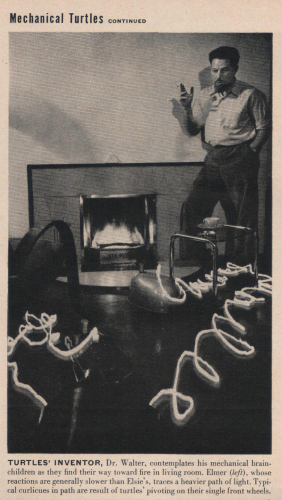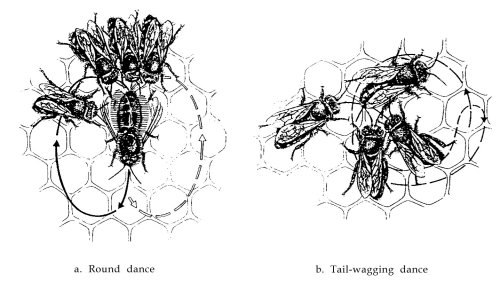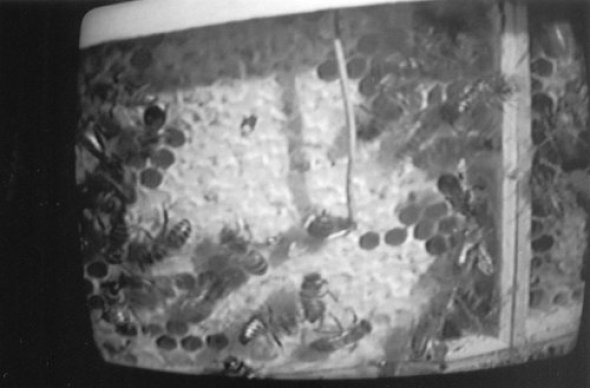Insect Oriented Media Theory
Jussi Parikka's recent book Insect Media simultaneously expands the field of media theory and the purview of biopolitics by thinking about the more-than-human development of communication environments. Review by Jennifer Gabrys
Ants and bees, spiders and moths, ticks and praying mantises can be found inhabiting the pages of Jussi Parikka's Insect Media. Arthropods and other bug-like creatures crawl, flap and flutter through this text as provocations for asking how we might read entomology as media theory. On the one hand, this guiding question is informed by the ‘realisation that basically anything can become a medium'; and on the other by the suggestion that the perceptual worlds that exist beyond human sensation and human use of media may begin to influence how we understand media and media theory. We may have grown accustomed to thinking of media as tools of content generation or entertaining diversion, as questions of users and consumer-based subjectivities, but this set of media debates and concerns is sidestepped to consider an alternative view of media as a more-than-human transfer of information that contributes to intensive material and environmental changes. With this material and distributed understanding of media, insects' chemical signals and haptic alerts may be considered media, where exchange of communication and affect is not understood as visual representation (as with human media), but rather as multisensory and more-than-human exchanges. At the same time, the swarming modes of organisation or distributed transfer of messages observed and interpreted within insect worlds may begin to influence new iterations of media technologies, from software to networks - thereby making our media decidedly posthuman in its formation and operation.
Bugs of all types congregate here not as representational ciphers, but rather as assemblages of sensation, event and environment that lead us to consider: what would a thoroughly posthuman media theory involve? As this text is issued through the Posthumanities series edited by Cary Wolfe and published by the University of Minnesota Press, it is a contribution to the various and varied examinations of what posthuman scholarship entails, from the companion canines of Donna Haraway to the Animal Capital of Nicole Shukin. In this context, Parikka mobilises ‘insects-to-think-with' to map out how nonhuman forces, potentialities and modes of sensation both influence the understanding and development of media technologies, and constitute a technics that is beyond the human. Media do not organise in direct or focal relation to ‘Man', in this analysis, but rather are read through swarming, distributed and collective ‘insectlike' agencies and affects.
The scope of Parikka's analysis spans from the 19th century to the cybernetic zoology of post-war experiments with computational organisms to software objects and clones that organise, reproduce and interact within insect-informed topologies. The book's seven chapters chart the enfolding of animality into modern technics, and make a specific case for insects as contributing to a decentred and distributed understanding of media. Parikka begins his analysis in the 19th century with the modern and materialist rise of Darwinian biology and an interest in the coupling of organisms and environments, followed by the emergence of technical media that capture and reproduce sensations often beyond human sense, and an increasing interest in insects as creatures that inhabit distinct perceptual worlds (here informed by the work of Jacob von Uexküll). With these events in mind, Parikka describes insects as creatures that have informed modern technics. But this development has to do with more than a metaphorical inspiration, since insects can be seen as ‘carriers of affects' (a phrase drawn from Uexküll). Insects describe vectors of becoming that are bound up with distinct relations and modes of communicating within and between bodies and environments. Yet these modes of becoming are multiply located, since the swarms, distributions and machine-oriented analyses of insects as automata emerge as much through situated human observations as conjectures about the specific sensory and relational worlds of insects.
Through an analysis of Uexküll's famous ‘conceptual animal', the tick, Parikka demonstrates how the distinct couplings of animals and environments, and the specific perceptual worlds at play in these relations, reshape conventional understandings of space away from a static backdrop and toward lived material relationalities that are composed of dynamic exchanges and modes of communication.1 Perception is not attached to fixed organs or a static reservoir of senses, but rather is a meeting of potentialities and multiple ways of communicating. Such an insight moves beyond phenomenology as a fixed process of subject-object decoding, to suggest that interactions with environments are key to the dynamic unfolding of sensation, and to the possibility for ‘an experimental empiricism'. In this analysis subjects, environments and media technologies are not characterised as fixed reference points or data-gathering centres, but rather as generative exchanges that unsettle a typical understanding of what transpires within communication.
Working across the theoretical contributions of thinkers such as Giles Deleuze and Felix Guattari, Elizabeth Grosz, Sanford Kwinter and Rosi Braidotti, Parikka draws together his insectlike insights with a body of contemporary theory that addresses the dynamic and deterritorialised possibilities for (post-)subjects. Insects, in this respect, can be read ‘as catalysts of relations', where these relations extend not just to nonhumans and their environments, but also to technics and technology, modernity and capitalism. The perceptual worlds at play in this analysis are more than sensory constructs, since they also inform the possibilities of the political and other modes of life. In this respect a biopolitical analysis of insect media is a key aspect of Parikka's project.
In his analysis of biopolitics, some poignant if unresolved questions emerge as to how this analysis of insect modalities can at once describe sites of potential becoming, while at the same time figuring within a contemporary logic of network control and capitalist economies. As Parikka asks,
Where, then, lies the potential radicality of swarms and the ‘insect model' when it has already, from the early days on, been integrated as part of the capitalist and bureaucratic models of creation, connected to Fordist models of labour, disciplinary modes of spatialisation and control, and hierarchical political structurations?
Insect logics of organisation have moved from the ant-like mechanics of the factory to the industrious cities of bees to the swarming patterns of stock markets to the distributed agencies of networks and cyborgian moths implanted with sensors as developed by the Defense Advanced Research Projects Agency (DARPA) programme.2 Here it is clear there is a careful traverse to be made between the problematic use of ‘biological metaphors' to ‘naturalise' economies and politics, and the incorporation of nonhuman potential as a way to encounter the potentially creative and intensive capacities of other organisms. In order to work through this prickly intersection, where creative potential may also be turned into a capitalist attribute, Parikka engages with Braidotti's suggestion that life is not just an ‘object of power' (or falling within a biopolitical realm, as conventionally understood), but is also a creative force in which technical media are involved, and which also may give rise to new ontologies of life.3 In this analysis, one is reminded of Haraway's cyborgian balancing act, where she attempts to engage at once with the military-industrial complex that was integral to the technologies she discussed, but also seeks to find other possibilities within these new bodies that could not be wholly relegated to stories of control.4

Image: William Grey Walter performs a cybernetic experiment with environment and perception using mechanical 'brain children'
One wonders then, how the ‘different ecological assemblages' that emerge through an insect media analysis might allow us to ‘summon a different kind of politics' as Parikka suggests, or ‘a politics aiming for the not yet existing in the sphere of bodies, sensations, and ethological relationality.' One way that Parikka approaches this question is by taking up the materiality of media as a site of further exploration. Taking a ‘milieu approach' to media, he suggests that the materiality of media should be rethought through the ‘nonhuman forces' that contribute to media assemblages, and that form distinct modes of materiality. This understanding of milieu and organism draws on Uexküll as well as the ‘cybernetic zoology that can be found in post-war experiments with automated tortoises and other ‘computational organisms' that became the basis for articulating new relations between perception and environmental stimuli, as well as new ontologies of life and information.5 These experiments with feedback are only part of the story, as Parikka suggests, since these insights direct us to move toward a more dynamic conception of environmental relations and, following Guattari, an ‘ecological view of subjectivity.'6
These environmental couplings are an interesting point of conjecture, since organisms and environments could be characterised as much by distributed responsiveness as by glitch and error. Could it be that the possible range of modes of relating could also be expanded, to incorporate not just organisation but also disorganisation and friction. While bugs in the computer-oriented sense of the word emerge in this study, another discussion of bugs can be found in Terry Harpold and Kavita Philip's recounting of the moth found by computer pioneer Grace Hopper in the Mark II electromechanical computer in 1945. A moth, lodged in the circuits of this machine, jammed a relay and was later found and saved in a log book as ‘the first actual case of a bug being found.'7 The moth is rendered as an intrusion into the spaces of information processing - a material body that is incompatible with the operation of this machine, and so becomes more than an entity to think with. While insects as automata may have informed the development of computational logic, here insects as creaturely bodies actually interrupt media technologies. Yet ‘bug' as a term used to describe mechanical error and glitch has been in use since the late 19th century. Given that this term precedes computer culture, it seems such interruptions and material dislocations could be an interesting way to explore the possibilities for other orders of relationality and cross-relationality, where insects are not just rendered into medial form, but also creep into our exchanges and so become a part of their disrepair or misfiring. Insects in this regard are not necessarily carriers of affect, but rather confuse or disrupt circuits through their distinct material inhabitations, thereby circumventing some transmissions while generating possibilities for other exchanges.
In a final sense, the turn toward insect-generated sound art and field recordings is a compelling example of how new modes of listening with bugs allows us to experience these distinct media-insect-environments as more than an apparently inchoate world of sounds. Several of these insect sound projects turn up in the epilogue to Parikka's study, which considers how the recordings of crickets and the microsounds and inaudible registers of hatching larvae enter into new media technical arrangements that give rise to new bodies, materialities and ecologies. Environments are then also dynamic contributors to these alternative renderings of media. Another example of such insect sound art that tracks these changes can be found in Hugh Raffles Insectopedia, a bug compendium also released in 2010 that investigates insects from a cultural historical perspective.8 In the entry, ‘The Sound of Global Warming', Raffles describes an arts-sciences collaboration that has made audible and legible the sound of bark beetles in piñon pine trees. The beetles, which are captured by David Dunn in his The Sound of Light in Trees soundscape project, are recorded along with a host of other insects that make strange sounds normally outside the range of perceptibility. By listening to beetles together with pines, however, distinct changes and activities can be discerned and translated that describe altering environments. Greater drought levels contribute to water stress for the trees, which then become more susceptible to beetle infestation. The media technics of insects signalling and working through their perceptual worlds, the dynamic shifts in environments, and the recording and translating of these sounds into other registers of human sense brings to our attention the ways in which posthuman media may also raise questions about trans-species relationships, changing environments, and the emerging politics, possibilities and obligations that may emerge at these intersections.9

Image: From Karl von Frisch's lecture, 'Decoding the Language of the Bee', University of Munich, 1973
This different type of responsiveness, and the expanded modes of participation made possible within media are a refreshing prospect, where media are not just carriers of versions of ourselves, but are also provocations for more-than-human perceptual relationships. These relationships move beyond the dynamic if closed coupling of organism and environment detailed by Uexküll, and instead suggest possible interactions across species worlds (hinting here at the ethical spaces of posthuman encounters, which are not just or even after the human, but also signal more-than-human residencies in the world). If insect media are not representations of worlds but practices that actively set worlds into motion, then these questions about how to locate and generate more creative counterparts to biopower, which Braidotti identifies and Parikka explores, is a crucial task. In this way, an ‘ecological view of subjectivity' might not orient us toward additional appropriations of insect capacities and attributes for a renewed project of humanism. Instead, it suggests that medial transmissions are sites for forming new collective encounters across bodies and concerns. Such a posthuman view on media and technics is not just a site for articulating existing environmental relations, but also for experimenting with inventive environmental relations through more-than-human perceptual worlds. The ‘intensive capacities' of media, bodies and environments that Parikka suggests allow us to rethink ‘the history of modern media and biopower' might then be understood as offering ways to engage with more-than-human worlds in order to tune more finely our multiple cohabitations.
Jennifer Gabrys is Director of the MA Design + Environment and Senior Lecturer in Design at Goldsmiths, University of London. She recently completed a book on electronic waste, Digital Rubbish: A Natural History of Electronics , and is currently working on a study of environments and sensing technologies, Program Earth: Environment as Experiment in Sensing Technology.
Info
Jussi Parikka, Insect Media: An Archaeology of Animals and Technology, Minneapolis: University of Minnesota Press, 2010
Footnotes
1 Jacob von Uexküll, A Foray in the Worlds of Animals and Humans, trans. Joseph D. O'Neil, Minneapolis: University of Minnesota Press, 2010 [1934].
2 Sally Adee, ‘Cyborg Moth Gets a New Radio', IEEE Spectrum, February 2009, http://spectrum.ieee.org/robotics/military-robots/cyborg-moth-gets-a-new-radio/0
3 Rosi Braidotti, Transpositions: On Nomadic Ethics (Cambridge: Polity, 2006).
4 Donna Haraway, ‘A Cyborg Manifesto: Science, Technology, and Socialist-Feminism in the Late Twentieth Century', in Simians, Cyborgs, and Women: The Reinvention of Nature (New York: Routledge, 1991), pp.149-181.
5 The automated or ‘robot tortoises' described here are a reference to William Grey Walter's cybernetic experiments with environment and perception through these particular computational organisms that tested his theories of brain development as a function of ‘nerve complexity'. Nerve complexity for Walter was an indication of the multiple interconnections that allowed for environmental inhabitation and exploration. The automated sensory animals that Walter developed were a way to test responsiveness to environments in order to understand communication as both embodied and embedded in environments. As Parikka writes, ‘This stance implies that communication is actually based in perception, and perception is furthermore conceptualized as an environmental being and a perceptiveness that Walter tried to hardwire into the speculating machines.' The difficulty with hardwiring perceptiveness is that it short-circuits the adaptive and learning-based modalities of environmental perception that Walter hoped to study with the tortoises.
6 Felix Guattari, Chaosmosis: An Ethico-Aesthetic Paradigm, Bloomington: Indiana University Press, 1995.
7 Terry Harpold and Kavita Philip, ‘Of Bugs and Rats: Cyber-Cleanliness, Cyber-Squalor, and the Fantasy-Spaces of Informational Globalization', Postmodern Culture 11, no. 1, 2000, http://muse.jhu.edu/journals/pmc/v011/11.1harpold.html
8 Hugh Raffles, Insectopedia, New York: Pantheon Books, 2010.
9 Jennifer Gabrys, Program Earth: Environment as Experiment in Sensing Technology (in preparation)
Mute Books Orders
For Mute Books distribution contact Anagram Books
contact@anagrambooks.com
For online purchases visit anagrambooks.com







